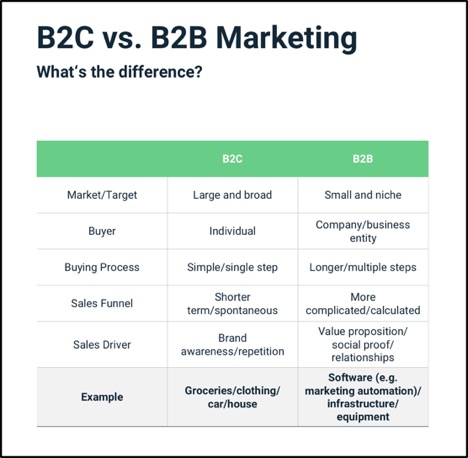What’s the difference between B2B and B2C? And why do you need to write differently for each acronym?
Well, B2B, or Business to Business, is a type of transaction that occurs between two businesses, while B2C, or Business to Consumer, is a type of transaction that occurs between a business and the final consumer.

For example, Zivtech is considered a B2B company because we offer our services to other businesses and organizations, never dealing directly with the end user. However, a company like Lyft is considered a B2C business because they offer their services directly to the consumer who will be using their product.
Since each type of transaction targets a different audience, it’s important to keep in mind who you’re creating content for. The tone in which you write, the type of content that you share, and where you share it depends on whether you’re speaking to a business or to an individual.
Tone
When you’re writing B2B content it’s best to take a professional approach. You’ll likely be targeting more than one person within an organization, so it’s important to appeal to different departments.
Your tone will differ slightly depending on what industry you’re in, but your focus should always be logical. A B2B audience makes decisions in a group based on a number of factors. When writing to a B2B audience it’s important to emphasize how your product or service will help solve their immediate business needs, whether that be to increase productivity or reduce costs.
When writing for a B2C audience you should take a relaxed, light-hearted approach. Consumers are more likely to stay engaged with your content if it appeals to their emotions, so make them laugh, or make them cry, either way, make them feel something.
With B2C content, you’re usually only targeting one individual consumer, so as long as you write for your established personas your content will end up being effective.
Type
It’s also important to know what type of content will be best received by your intended audience.
For B2B, you should focus on content that provides value and educates the reader. White papers are great for this because they are long-form and tend to be more technical and in-depth. They’re also a great way to present your company’s own findings and solutions.
If you decide to go the route of social media, a LinkedIn post is a great way to get your content in front of other organizations and industry professionals. For B2C content, you’d likely have a better chance at reaching your audience directly via a Facebook or Instagram post since these platforms target individual users.
Ebooks are also useful for B2C content writing because they’re typically shorter and easier to digest. Ebooks include a lot of images and usually complement the product or service you're selling. For example, if you sell clothes, you might offer a style guide to your customers.
Channel
After you write great content, you’ll want to ensure that it reaches your target audience and doesn’t end up floating in the abyss.
For B2B content, your best channel of distribution is email. An email or a direct message will guarantee that your content is reaching the eyes of those in charge of making decisions. To avoid bombarding people with multiple emails, put together a monthly or quarterly newsletter that includes blog posts and case studies.
Speaking of blog posts, a B2B blog is really valuable because it keeps all of your quality content in one place. Your blog should establish your company as being a thought leader in your industry, and the content should focus on helping other organizations solve their business needs.
A good rule of thumb when it comes to B2C content distribution is to reach your audience where they are most often. This usually means using social media to engage directly with your consumers. Social media is a great way to reach your consumers on a more personal level.
When it comes to writing content for both B2B and B2C businesses the first thing you should always do is determine your target audience. Once you know who you’re writing for, you’ll know how to write for them.
Remember, there will always be exceptions to these rules. Make sure that regardless of if your organization is B2B or B2C, that you’re writing content that best reflects your business.
